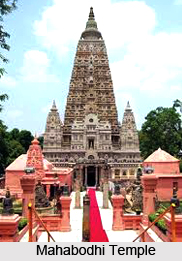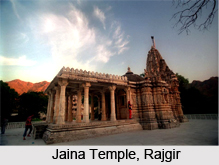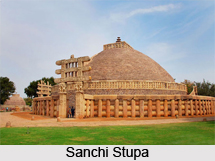 Indian Buddhist sites are numerous in number which are scattered throughout the length and breadth of Asia. A majority of these renowned regions are closely associated with the life of Lord Gautama Buddha and have been visited by Buddha either for preaching Buddhist principles or for meditation. To transform himself from `Siddhartha` to `Sakyamuni` and then to Buddha he had travelled far and wide on various purposes. All those places that he went to are considered as Buddhist pilgrimage centres. However at some centres excavations have been carried out to know more about the great teacher. These are the historical Buddhist sites that are related with his early life. There exists four significant centres of Buddhist pilgrimage which include the birthplace of Buddha at Lumbini, the area where he achieved `Enlightenment` known as Bodhgaya, the region which received His very first teachings called Benaras and the place where He attained `Parinirvana` at Kushinagara.
Indian Buddhist sites are numerous in number which are scattered throughout the length and breadth of Asia. A majority of these renowned regions are closely associated with the life of Lord Gautama Buddha and have been visited by Buddha either for preaching Buddhist principles or for meditation. To transform himself from `Siddhartha` to `Sakyamuni` and then to Buddha he had travelled far and wide on various purposes. All those places that he went to are considered as Buddhist pilgrimage centres. However at some centres excavations have been carried out to know more about the great teacher. These are the historical Buddhist sites that are related with his early life. There exists four significant centres of Buddhist pilgrimage which include the birthplace of Buddha at Lumbini, the area where he achieved `Enlightenment` known as Bodhgaya, the region which received His very first teachings called Benaras and the place where He attained `Parinirvana` at Kushinagara.
Bodhgaya
Bodhgaya is one of the most well known places for Buddhists which lies in the eastern Indian state of Bihar. The most important attraction here is the Bodhi tree under which Gautama attained Enlightenment. Another attraction here is the Mahabodhi Temple. It is believed to have been built by emperor Ashoka.
Sarnath
The Deer Park in Sarnath is the place where Buddha delivered his first discourse, through which he had preached the `four noble truths` and their associated principles. The place is situated near Varanasi, Uttar Pradesh. Today there are some of most exquisite Buddhist monuments in Sarnath. Probably the most important of them all is the Ashokan Pillar. A Buddhist temple and the ruins of the several monuments add to the beauty of this historical Buddhist site.
Kushinagar
Kushinagar town in Uttar Pradesh is the site where Lord Buddha attained Parinirvana following His demise and it was referred to as `Kushavati` or `Jatakas` during ancient periods. Ramayana has mentioned about this region as `Kusha` city, named after Rama`s son. Buddha attained `Mahaparinirvana` or the `Final Nirvana`, immediately after he had consumed meals prepared with mushrooms. The `Viharas` and `stupas` located here belong to the 3rd or 5th century CE and Ashoka had erected several Buddhist monuments here.
Rajgir
Rajgir, situated in Bihar was once a capital of the Magadha kingdom which later developed into Mauryan Empire and is believed to have come into existence during 1000 BC. It is a notable Buddhist site as the `Atanatiya` conference was held here, at the mountain of the Vulture`s Peak. Lord Buddha had been engaged in deep meditation for a considerable amount of time and delivered His lessons at `Gridha-Kuta` or the Hill of the Vultures. Some of the most famous sermons were taught here and King Bimbisara had converted to Buddhism at Rajgir.
Vaishali
Vaishali is present in Bihar and is called so since it was extensive or `Vishal` as per the Hindi language, according to a Theravadin scholar and Buddhist commentator known as Buddhaghosa who lived during the 5th century. It was here that Lord Buddha had imparted his final sermon, prior to His death during 483 BCE. Currently, Vaishali is an important archaeological centre in the nation. King Kalasoka had organised the Second Buddhist Council in the 383 BCE and Vaishali is home to the well preserved Ashokan Pillars, which is adorned with a single Asiatic Lion at its summit. Travelogues of Chinese travellers like Zuanzang and Fazian contain references of this Indian city.
Sanchi
This Buddhist site is located in Madhya Pradesh, India. This is the place, which was converted to a Buddhist retreat. The Great Stupa here was built by emperor Ashoka and is said to be amongst the most ancient stone structures in India. It is one of the many Buddhist sites for which the emperor contributed in money and kind during the 3rd century BC. A series of `Torana` surround the Sanchi Stupa and the subtle elements of courage, love, peace and trust have been represented in the form of these toranas. 
Ajanta
The figure of `Padmapani` or `Avalokiteshvara` is to be found here. There are 30 rock-cut Buddhist caves at Ajanta in Maharashtra. From elaborate monastic halls to beautiful Buddhist wall paintings, all such magnificent creations are parts of this place. These wall paintings are considered exquisite masterpieces of Buddhist art, embellished with images of various Jataka tales and numerous events of the life of Lord Buddha. Since the year 1983, Ajanta Caves have been declared a UNESCO World Heritage Site preserved by the Archaeological Survey of India or ASI.
Nelakondapally
Based in the southern Indian state of Andhra Pradesh, Nelakondapally town consists of several Buddhist relics like terracotta idols, a miniature limestone Buddhist stupa, brick-made Viharas, cisterns, a beautiful bronze figurine of Lord Buddha and a large variety of numerous other artefacts belonging to the 3rd and 4th century which have been excavated. Important archaeological sites including Keechaka Gundam and Virtaraju Dibba which can be traced back to the age of the Mahabharata are all situated at a distance of nearly 1.6 km from Nelakondapalli.
Other Buddhist Sites of India
Apart from these Buddhist sites in the country, India boasts of innumerable other Buddhist archaeological regions which are extremely popular tourist locales. Nalanda in Bihar, Tabo Monastery, Rumtek Monastery in Sikkim, Shanti Stupa in Leh-Ladakh, Tawang Monastery in Andhra Pradesh, Namdroling Monastery near Mysore in Karnataka, Bojjannakonda, Guntupalli, Ghantasala, Bhattiprolu, Pavurallakonda, Phanigiri etc in Andhra Pradesh, Bagh Caves in Madhya Pradesh, Harvan, Panderathan and Parihaspura in Kashmir and Vadnagar in Gujarat. Besides these places there are other important historical places that lie outside India but are crucial to Buddhist history.



















